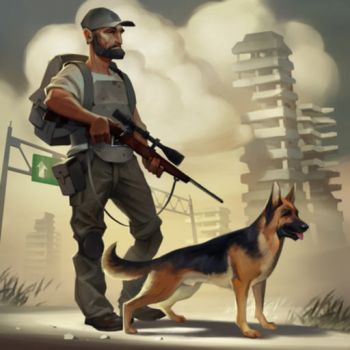- iOsGG.com
- First and foremost, Welcome to our forum! Read the rules after you registered!

Chalk
Advanced Member-
Content count
21 -
Donations
$0.00 -
Joined
-
Last visited
About Chalk
-
Rank
Advanced

Device
-
Device
iPhone 8 Plus
-
Version
iOS 11
-
Jailbreak
no
-

Build Away! - Idle City Game v2.5.6 [Free IAP/Free Store]
Chalk replied to Cz1993's topic in Free Non-Jailbreak Hacks
B-1 Lancer A B-1B flying over the Pacific Ocean RoleSupersonic strategic heavy bomber National originUnited States ManufacturerNorth American Rockwell/Rockwell International Boeing First flight23 December 1974 Introduction1 October 1986 StatusIn service Primary userUnited States Air Force Produced1973–1974, 1983–1988 Number builtB-1A: 4 B-1B: 100 Unit cost B-1B: US$283.1 million in 1998[1]($400 million in 2016 dollars[2]) The Rockwell B-1 Lancer[N 1] is a supersonic variable-sweep wing, heavy bomber used by the United States Air Force. It is commonly called the "Bone" (from "B-One"). It is one of three strategic bombers in the U.S. Air Force fleet as of 2018, the other two being the B-2 Spirit "Stealth Bomber", and the B-52 Stratofortress. The B-1 was first envisioned in the 1960s as a platform that would combine the Mach 2 speed of the B-58 Hustler with the range and payload of the B-52, and would ultimately replace both bombers. After a long series of studies, Rockwell International (now part of Boeing) won the design contest for what emerged as the B-1A. This version had a top speed of Mach 2.2 at high altitude and the capability of flying for long distances at Mach 0.85 at very low altitudes. The combination of the high cost of the aircraft, the introduction of the AGM-86 cruise missile that flew the same basic profile, and early work on the stealth bomber all significantly affected the need for the B-1. This led to the program being canceled in 1977, after the B-1A prototypes had been built. The program was restarted in 1981, largely as an interim measure until the stealth bomber entered service. This led to a redesign as the B-1B, which had lower top speed at high altitude of Mach 1.25, but improved low-altitude performance of Mach 0.96. The electronics were also extensively improved during the redesign, and the airframe was improved to allow takeoff with the maximum possible fuel and weapons load. The B-1B began deliveries in 1986 and formally entered service with Strategic Air Command (SAC) as a nuclear bomber in 1986. By 1988, all 100 aircraft had been delivered. In the early 1990s, following the Gulf War and concurrent with the disestablishment of SAC and its reassignment to the newly formed Air Combat Command, the B-1B was converted to conventional bombing use. It first served in combat during Operation Desert Fox in 1998 and again during the NATO action in Kosovo the following year. The B-1B has supported U.S. and NATO military forces in Afghanistan and Iraq. The Air Force had 66 B-1Bs in service as of September 2012. The B-1B is expected to continue to serve into the 2030s, with the Northrop Grumman B-21 Raider to begin replacing the B-1B after 2025. The B-1s currently in inventory will be retired by 2036.[3] -

Angry Birds Epic RPG By Rovio v3.0.1 +2 Hacks [Direct Install]
Chalk replied to Cz1993's topic in Free Non-Jailbreak Hacks
-

Strike Back: Elite Force - FPS Zombie Shooter Game v1.4 +1 [ Free Store! ]
Chalk replied to Cz1993's topic in Free Non-Jailbreak Hacks
-

Partymasters - Fun Idle Game By Playgendary v1.0 [ Free Store! ]
Chalk replied to Cz1993's topic in Free Non-Jailbreak Hacks
-
-

Last Day On Earth: Zombie Survival v1.17.1 [Mega Hack +50++] [Direct Install!]
Chalk replied to Cz1993's topic in Free Non-Jailbreak Hacks
-

[FREE] Snipers vs Thieves: FPS Clash By PlayStack Ltd v1.9 +2 Hacks
Chalk replied to Cz1993's topic in Free Non-Jailbreak Hacks
-

[iOsGG Exclusive] The Simpsons™: Tapped Out v4.44.0 [Unlimited Donuts!] [Direct Install]
Chalk replied to Cz1993's topic in Free Non-Jailbreak Hacks
-

Last Day On Earth: Zombie Survival v1.9.7 [FREE STORE!]
Chalk replied to Cz1993's topic in Free Non-Jailbreak Hacks
-

Real Racing 3 +3 Jailed Cheats [ All Cars Unlocked ]
Chalk replied to MyCysero's topic in Free Non-Jailbreak Hacks
-

Tiny Troopers 2: Special Ops By EA Chillingo Hack
Chalk replied to Cz1993's topic in Free Non-Jailbreak Hacks
-

Subway Surfers By Kiloo v1.85.0 [Free IAP/Free Store]
Chalk replied to Cz1993's topic in Free Non-Jailbreak Hacks
-

[FREE] The Sims™ Mobile By Electronic Arts v22.0.0 [Unlimited SimCash & More] [Direct Install]
Chalk replied to Cz1993's topic in Free Non-Jailbreak Hacks
-
-

[FREE - iOsGG Exclusive] PUBG Mobile v0.8.1 +4 Non Jailbreak Hacks [Direct Install!] [Fixed]
Chalk replied to Cz1993's topic in Free Non-Jailbreak Hacks
















